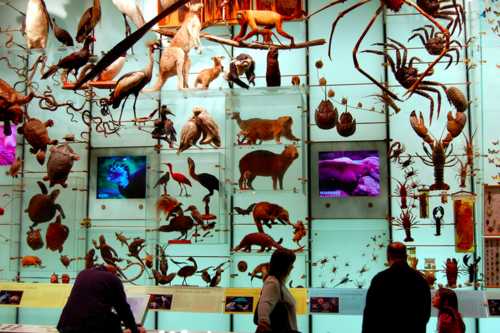
Biological diversity, also more commonly referred to by its contracted form of biodiversity generally refers to the variability of all life forms. In particular, it refers to the grand total or sum of all genes, species, habitats and natural processes constituting the makeup of all life on Earth.
A relatively recent creation, the word "biodiversity" is derived from the Greek word "bio" and the Latin word "diversitas". Yet even though the word is new in the lexicon of English words, it's an old concept and one we've all been familiar with innately and for time immemorial. Biodiversity underpins the food we eat, the clothes we wear, the houses we live in and the activities we perform. It provides many services without which we could not survive.
Biodiversity is complex. Despite our awareness of it as a concept and of portions of it affecting our lives, health and well-being, the part we can see is but a small portion of the whole. Beyond the animals and plants we can see, there are the ones we cannot (whether by reason of location, distance or camouflage). Then there are the fungi and bacteria, as well as those organisms that share characteristics of both plants and animals, all of which form part of the greater biodiversity.
Biodiversity consists of three components: The genetic, species and ecosystem components.
Species diversity
Species is the basic unit by which biodiversity is measured. Biodiversity at the species level consists of the variety of species found.
Genetic diversity
Genetic diversity represents another level of biodiversity. This refers to the genetic variation that exists within species' individuals. Genetic diversity is important because it is at this level that adaptations to environmental conditions can occur, improving the chances of those individuals to survive and thrive in different environmental conditions. Genetic variability is essential for evolution of the species.
Ecosystem diversity
There is a vast amount of diversity of ecosystems on Earth, in which communities of species both interact with one another and form integral parts of, forming part of the ecological processes that help the ecosystem to function. Ecosystems include water, desert, forests, tundra, grasslands, coasts, swamps, estuaries, coral reefs, and more.
What brings about diversity?
There are various driving forces behind the resulting diversity of life on planet Earth. These include:
- Climate: The climatic conditions determine the favourability of areas for plant growth, which in turn affects the diversity of other species interacting with plants.
- Expansion: Species will move into new areas where their biology permits and where the physical barriers are not monumental. Environmental barriers that can prevent expansion include water, mountains, and deserts. Water or air temperature can affect the ability to expand also.
- Isolation: Sometimes a population is cut off from other members of its species, such as when islands form. In this case, the isolated population will evolve differently from the same species it once shared space with elsewhere.
- Time: The development of diversity happens over (and indeed requires) time. Once barren areas can become fertile as time goes on, allowing diversity to spring up, such as after landslides or volcanic explosions.
- Human input: Direct human decisions to create different varieties within a species can increase the diversity. Dogs, livestock and crop plants are example of this. Human input also has negative effects on biodiversity, such as extinction, introduction of invasive species and loss of habitat.
Megadiverse countries and hotspots
Megadiverse countries have places where the level of biodiversity is high, and the group of countries with this status covers 10 percent of Earth's global surface but contains 70 percent of Earth's biodiversity.[1]
The world's megadiverse countries are:[1]
- Australia
- The Congo
- Madagascar
- South Africa
- China
- India
- Indonesia
- Malaysia
- Papua New Guinea
- Philippines
- Brazil
- Colombia
- Ecuador
- Mexico
- Peru
- United States
- Venezuela
Biodiversity hotspots refer to areas which have largely intact ecosystems that contain a good representation of the native species and communities that typically form part of the relevant ecosystem.[1]
Causes versus indicators of the loss of biological diversity
There is a distinction between the causes of biodiversity loss and the indicators of such loss.
- Indicators of biodiversity loss include: Habitat destruction, pollution, over-harvesting and the illegal use of natural resources.
- Causes of biodiversity loss include: Land tenure, poverty, social and cultural beliefs/pressures, population shifts, political and economic failures, etc.
See also
- Community conservation of biodiversity (ways that you and your community can help to conserve and improve biodiversity in your area)
External links
- Beaty Biodiversity Museum - http://beatymuseum.ubc.ca/
- Biodiversity Online - https://www.biodiversity.govt.nz/
- IUCN Biodiversity - http://www.iucn.org/what/biodiversity/
- World Heritage Sites Areas of Biodiversity Importance - http://www.biodiversitya-z.org/content/world-heritage-sites-whs
- Biodiversity Hotspots - https://www.environment.gov.au/biodiversity/conservation/hotspots